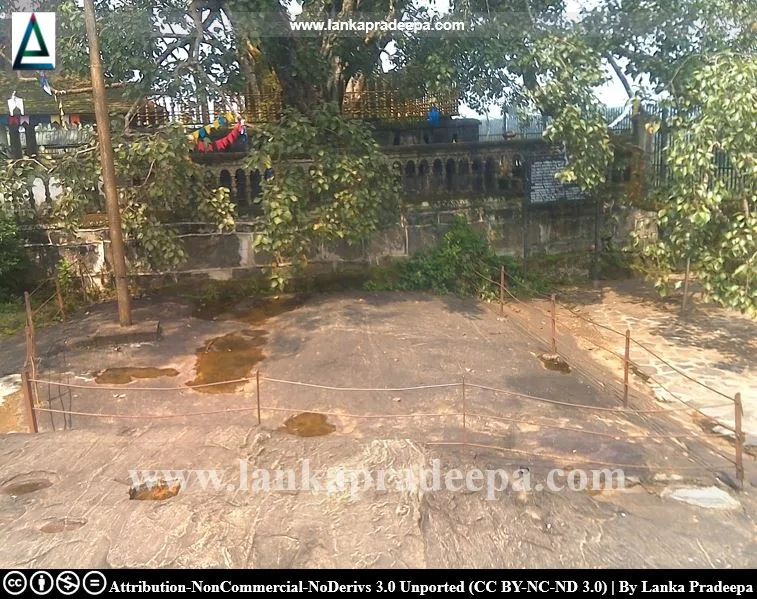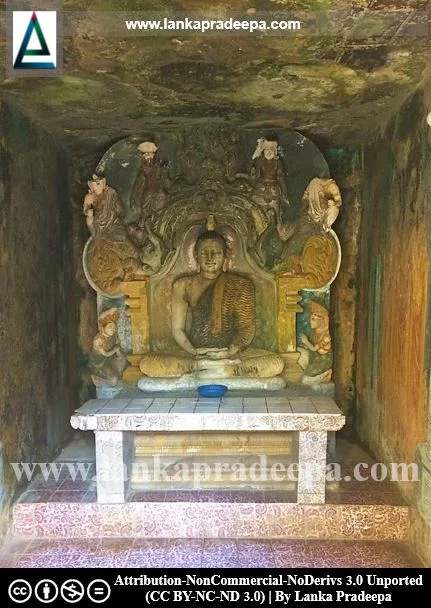
Gadaladeniya Viharaya, also known as Sri Saddharmathilaka Raja Maha Viharaya (Sinhala: ගඩලාදෙණිය විහාරය) is a Buddhist temple situated in Gadaladeniya village in Kandy District, Sri Lanka.
History
The history of the Gadaladeniya temple goes back to the Gampola Period. According to epigraphic sources, the Buddha shrine and Devalaya at Gadaladeniya were erected by the great monk Dharmakirti Sthavira during the reign of King Buvanekabahu IV (1341-1351 A.D.) in the Saka year 1266 which is 1344 A.D. (Abeywardana, 2004; Paranavitana, 1934; Seneviratna, 1983). The temple was repaired later by King Parakramabahu VI [(1412-1467 A.D.) Seneviratna & Polk, 1992].
Although this temple is presently known as Gadaladeniya Viharaya, the inscriptions in situ name it Dharmakirti Viharaya after the name of the founder monk (Seneviratna, 1983). The Nikaya Sangrahaya (14th century) names it Saddharmatilaka while the Saddharmalankaraya calls it Gadaladeniya Viharaya after the name of the village (Seneviratna, 1983).
Several celebrated scholarly monks who have contributed to the literary development of the country, such as Dharmakirti II and Vimalakirti I, are said to have resided at Gadaladeniya temple (Seneviratna, 1983; Seneviratna & Polk, 1992). Presently, the temple is looked after by the pupillary succession of Ven. Weliwita Sri Saranankara Sangharaja Thera [(1698 - 1778 A.D.) Abeywardana, 2004].
Inscriptions
Several inscriptions have been found on the temple premises. Among them, two inscriptions are found inscribed on a slab-pillar erected near the entrance of the Buddha shrine. Another two are on the rock near the Bodhi tree and five inscriptions are found on the rock plain near the steps of the south entrance gate of the temple (Paranavitana, 1934).
Gadaladeniya Slab-Pillar Inscription
This slab-pillar with inscriptions was found inside the temple by H. C. P. Bell, the then Archaeological Commissioner (Codrington, 1934). It contains two inscriptions inscribed on its four surfaces. The first of the two is a record of the fifth year of King Siri Sangabo Sri Jayavira Parakrama Bahu granting amnesty to Menawara Tunayan, nephew of the Apa Parakramabahu of Dodamwela and the people of the five countries (Codrington, 1934). The second inscription records that Menawara Tunayan, nephew of the Apa Parakramabahu of Dodamwela, and all others were given amnesty by King Siri Sangabo Sri Jayavira Parakrama Bahu (Codrington, 1934).
Five Rock Inscriptions near the South Entrance

I) This is a 15th-century Sinhala inscription containing four lines. It mentions a king styled Sirisangabo Sri Parakramabahu Vikramabahu (Paranavitana, 1934).
II) This is also a 15th-century Sinhala inscription containing five lines. It has been inscribed in the third year of Sirisangabo Sri Parakramabahu (Paranavitana, 1934).
III) Gadaladeniya Inscription of Dharmakirti Sthavira
This is the earliest and lengthiest inscription (45 lines) at the site. Inscribed in the 3rd year of King Bhuwanekabahu IV, this inscription is considered important as it contains details about the history of Gadaladeniya Viharaya.
The inscription which has been written in modern Sinhala scripts is dated to 1344 A.D. It records the construction of the Buddha shrine at Gadaladeniya by the great Thera Dharmakirti Sthavira of the Ganavasi school and a list of lands dedicated to it by various personages.
It further reveals that Sthavira Dharmakirti had constructed or repaired a two-storied image house at Sri Dhanyakataka (i.e. Amaravati) in India, before the construction of the Gadaladeniya temple (Paranavitana, 1934). Senarath Paranavithana points out this fact as an example that shows the efforts made by Sri Lankan Buddhists of the fourteenth century to revive Buddhism in South India (Paranavitana, 1934).
IV) Gadaladeniya Inscription of Senasammata Vikramabahu
This inscription has been inscribed in the eighth regnal year of King Senasammata Vikramabahu (1469-1511 A.D.). It records a proclamation made by Senasammata Vikramabahu, his son Yapa Bandara and other important persons to effect that no loss of life shall happen in certain territories of the Kandyan Kingdom.
V) This weathered inscription has been dated to 2054 of the Buddhist era (1511 A.D.). The name of the king mentioned in this epigraph is Jayavira (Codrington, 1934).
Architecture
The architecture of the Gadaladeniya temple is similar to the contemporary Hindu shrines of South India in the early Vijayanagar style (Abeywardana, 2004; Paranavitana, 1934). According to the Gadaladeniya inscription of Dharmakirti Sthavira, the architecture of this temple was designed by Ganeshvarachari who is believed to be an architect from South India (Paranavitana, 1934; Seneviratna, 1983).
Buddha shrine

The Buddha shrine is built entirely of sculptured granite, except at the Shikharas where the top is built of bricks (Seneviratna & Polk, 1992). The shrine consists of a Garbha-gruha (a sanctum), an Antharalaya (a vestibule), a Devalaya, and a porch. The Garbha-gruha is the most inner part of the shrine and it accommodates a large statue of the seated Buddha who is in a pose of meditation under a Makara Thorana (a dragon arch). The Makara Thorana is decorated with images of gods such as Sakra, Brahma, Suyama, Santusita, Natha, and Maitri (Seneviratna & Polk, 1992).
The Devalaya is in a separate chamber that projects from the Antharalaya part. According to the inscription of Dharamakirti Sthavira, the Devalaya has been built for the protection of the Viharaya (Abeywardana, 2004). The deity who is being worshipped at the Devalaya is presently God Vishnu [(previously God Upulvan) Seneviratna, 1983].
The two upper stories of the Buddha shrine are non-functional and form the stone base for the Sikhara which is in the shape of a Stupa (Seneviratna, 1983). This type of Sikhara is found in the Natha Devalaya and at Gedige Viharaya in Kandy (Seneviratna, 1983).
Vijayothpaya
The structure which consists of a central main Stupa surrounded by four other small-size Stupas is called Vijayothpaya (or Vijayantha Prasada). As the Buddha shrine, the Vijayothpaya at Gadaladeniya temple is also believed to be constructed by Dharmakirti Sthavira (Rajapakse, 2016).
The central Stupa has been built on a square-shaped elevated platform built of stone. It is covered by a four-sided roof supported by four pillars. The roof is built of timber and belongs to the Kandyan style. It is said to be added to the Vijayothpaya by King Parakramabahu V [(1344/1345 - 1359 A.D.) Rajapakse, 2016; Seneviratna, 1983]. On the four sides of the central Stupa are four small Stupas built on platforms containing shrine rooms (de Thabrew, 2013).
The Chapter House, the Vahalkada, the Sinhasana Mandapaya, and the Dig-geya are among the other significant structures of the Gadaladeniya temple (Rajapakse, 2016).
A protected site
The ancient Buddha shrine, Devalaya and rock inscriptions situated in Gadaladeniya Raja Maha Vihara premises in Udunuwara Divisional Secretary’s Division are archaeological protected monuments, declared by a government gazette notification published on 11 May 1956.




.
References
1) Abeywardana, H.A.P., 2004. Heritage of Kandurata: Major natural, cultural and historic sites. Colombo: The Central Bank of Sri Lanka. pp.74-75.2) Codrington, H. W., 1934. The Gadaladeniya Inscription of Senasammata Vikrama Bahu. and The Gadaladeniya Slab-pillar inscriptions. Epigraphia Zeylanica being lithic and other inscription of Ceylon. Vol. IV. Archaeological Survey of Ceylon. London. pp.8-15,16-27.
3) de Thabrew, W. V., 2013. Monuments and Temples of Orthodox Buddhism in India and Sri Lanka. Author House. p. 66.
4) Paranavitana, S., 1934. Gadaladeniya Rock Inscription of Dharmakirti Sthavira. Epigraphia Zeylanica being lithic and other inscription of Ceylon. Vol. IV. Archaeological Survey of Ceylon. London. pp.90-110.
5) Rajapakse, S., 2016. Pauranika Sthana Ha Smaraka: Mahanuwara Distrikkaya (In Sinhala). Archaeological Department of Sri Lanka. ISBN:955-9159-34-8. pp. 58-60.
6) Seneviratna, A, 1983. Kandy: An Illustrated Survey of Ancient Monuments, with Historical, Archaeological, and Literary Descriptions Including Maps of the City and Its Suburbs. Central Cultural Fund. Ministry of Cultural Affairs. pp.117-119.
7) Seneviratna, A. and Polk, B., 1992. Buddhist monastic architecture in Sri Lanka: the woodland shrines. Abhinav Publications. p.82.
8) The government gazette notification. No: 10928. 11 May 1956.
Location Map
This page was last updated on 7 October 2022

